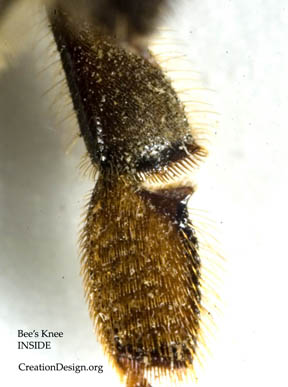Articles
The Bee's Knees
The Creator designed the entire body of the bee with a purpose in mind. There is no randomness on the bee's body. The knees are another example of the design found in all aspects of the bee's body.
The upper and lower outside portions of the hind legs of the bee are equipped with plates that are designed to hold and to transport pollen. These plates contain a hollowed-out area in the knee on both the upper and lower segments. There are hairs that reach around the hollowed-out area on the upper and lower segment to form a basket-like structure for the purpose of transporting pollen. These hairs hold the sticky pollen together as it clumps over the outside of the knee. In the center there are other hairs that reach across the joint to hold the pollen on the bottom of the upper concave area. These hairs reach downward just far enough to facilitate the loading of the pollen. The loading of the pollen is accomplished primarily through the use of a comb that is placed on the inside of the knee.
 
The inside of the Bee's knee is entirely different from the outside. The inside contains no concave surface for storing pollen or long hairs to hold it, because the knee is designed to transport pollen only on the outside. The inside contains a very pronounced comb that is placed on the inside of the knee joint directly opposite to the slightly v-shaped surface of the lower knee. The Creator designed it this way in order to provide the bee with the ability to preen the pollen off of the numerous hairs on the body and to load the pollen into the pollen holders on the hind legs. The v-shape construction on the lower joint is designed to form a tiny channel so that the joint may be closed on the antennae or other appendage and the pollen combed off by pulling the appendage through the joint like pulling a thread through a needle. The knee joint also opens to expose the comb to flat surfaces on the bee's body so the bee can comb the honey from its body hairs into the carrying "baskets" on its legs. The long hairs that wrap around the concave area also serve as combs to comb the pollen into the holders. In order to do this, the joints of the hind legs must be designed with extreme flexibility so that the legs can reach the upper body.
All of these evolutionary "accidents" must coincide with the instinct of the bee to comb only in the direction that will sweep the pollen on to the outside of the leg and into the "basket" rather than to the inside of the leg. Note that not one stray holding hair is found on the inside of the leg. Why? Not because some accidental mutation removed it, but because it was not part of the intended design.
 |
The upper and lower segments of a bee's knee on the nib of a fountain pen. The bee stores the pollen at the intersection of these two joints. |
The bee's knee is, of course, quite small. It can sit comfortably on the tip of a fountain pen. Yet a much smaller space was obviously designed for pollen and even smaller mechanisms such as the comb and the joint were designed to gather the pollen. A bee must work a lifetime in order to carry enough pollen to make 1/12 of a teaspoon of honey.
Where did the bee's knees and the pollen basket come from? There can be no question that they were designed to collect pollen in order to make honey. The only question is who designed them? Were they really "designed" by accidental changes and survival of the fittest? If so, then where is the evidence to show this? The evidence here points to an intelligent design.
Where is the evidence that the pollen baskets simply appeared on the legs of some primordial wasp at the same time other glands were changing equally by chance to produce the chemicals necessary to transform pollen into the amazing substance called honey? Equally imaginary is the contention that all the newly created bees that had pollen baskets decided to work together to make honey. There is no empirical evidence for this transformation. None whatever. Evolution's answer is essentially that they must have evolved rather than having been created because evolution cannot posit the existence of a Creator.
Please consider this for a moment. If your mind were truly open and if you could look at what you see here with the purest of objectivity, would you really conclude that all this was caused by a series of billions or trillions of extremely fortunate beneficial mutations and the survival of the fittest?
Or would you conclude that the bee's body was designed and constructed by a designer?
There is, of course, ample evidence of natural changes within a species, eg. gypsy moths, bacteriological resistance to drugs or dog breeds, where pre-existing traits are suppressed by environmental pressures. But where is the evidence of Darwinian Evolution (beneficial mutations creating an entirely new species)? Where is the evidence of these unobserved mutations turning a wasp into a bee or an ape into a man? There is no such evidence.
Evolution argues that 1) evolution is scientific and creation is religious, 2) religion has no part in science, 3) evolution will not consider any aspect of a Creator, so evolution is the only explanation for all of life. Evolution uses its refusal to consider the Creator as its argument to prove that the Creator did not create! All evolution and religion aside, this is circular reasoning at its apex.
Evolution takes the impenetrable position that a Creator did not create because evolution presumes a priori that a Creator either does not exist or that He is irrelevant. Because of this a priori presumption, no amount of impossibilities will ever alter this position. The foundation of evolution therefor rests directly upon a theological conclusion regarding the existence of God.
The difference between the theological element of evolution and the theological element of intelligent design is that the theological position taken by evolution is an a priori assumption (unproven) and the theological position taken by intelligent design is a conclusion that follow from the evidence.
If evolutionary scientists were truly objective, they would presume nothing about the Creator - neither existence nor non existence. And then they would consider the evidence and draw their conclusions from the evidence. But evolutionary scientists are not objective and they will consider nothing that they can neither understand nor control.
http://www.creationdesign.org/Honeybee.html
|

